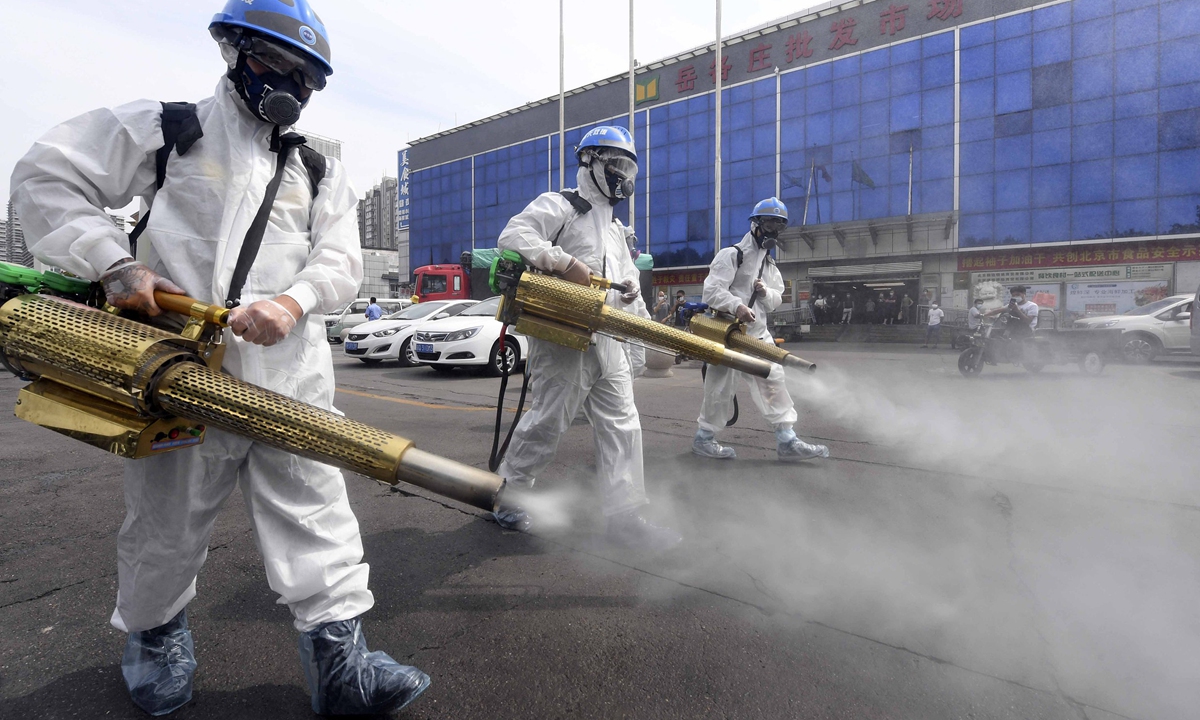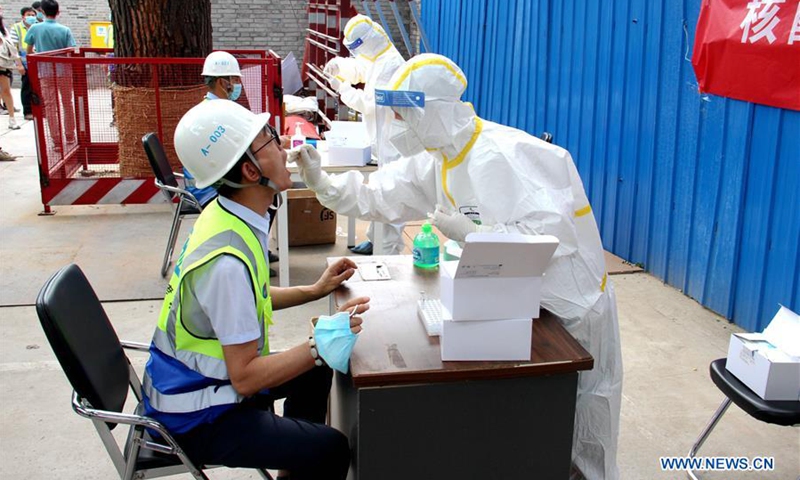China submits latest genome sequence to WHO at record speed
By Zhao Yusha and Zhang Hui Source:Global Times Published: 2020/6/19 22:38:40

From Beijing's Xinfadi market, where the capital's outbreak flared up, virologists from China's Center for Disease Control and Prevention (CDC) took substantial coronavirus-positive samples three times and published a groundbreaking discovery that the virus causing Beijing's latest outbreak came from Europe, yet it has existed longer than the coronavirus strain in Europe, or may be more contagious.
Chinese scientists spent only a week to work out the genome sequence data of the coronavirus that caused Beijing's outbreak and shared it with the international community, a development that experts said could assist virus tracing and finding patient zero in the capital to stem the spread.
Experts suspect that a super spreader may be lurking in the capital, as the market was severely contaminated by the virus and a large number of patients, all linked to Xinfadi, have been found in Beijing. But it raised the question of whether the outbreak had been brought under control in the capital.
From Europe, but older
The finding that the coronavirus strain detected at Xinfadi in Beijing came from Europe was included in a detailed epidemiological survey published on the website of the Communist Party of China (CPC) Central Commission for Discipline Inspection (CCDI) on Friday, yet the virus found in Xinfadi has existed longer than the coronavirus strain circulating in Europe, CDC virologists said.
Since the outbreak at Xinfadi, virologists from China's CDC have visited the now closed market three times - on June 14, 15 and 17 - and announced a groundbreaking discovery.
Zhang Yong, an assistant director of the National Institute for Viral Disease Control and Prevention of the CDC, said in the CCDI article that "the large amounts of samples found in the Xinfadi wholesale market indicate that the virus has been around for some time. If it had just arrived in the city, there may not have been so many positive samples found. However, we need more data before making an informed decision about its origin," Zhang said.
The coronavirus is particularly cold-resistant and can survive for months at -4 C and 20 years at -20 C, which explains why the virus has been found several times in seafood markets, and can be transported across borders, Chinese epidemiologist Li Lanjuan said on Friday.
Experts said it is possible that the virus did not mutate during transport as it has been sealed in frozen food, and stored in cold and damp conditions.
Based on the known facts, we can speculate that the virus that caused Beijing's latest outbreak existed as early as January, Yang Zhanqiu, the deputy director of the pathogen biology department at Wuhan University, told the Global Times, noting that almost 200 people got infected within a week, meaning the virus is more contagious than its Chinese peer.
The virus may be a subtype of the coronavirus in Europe, and no matter when it came to China, it only caused the outbreak now because different races have different immunities to the virus, Yang said. He explained it is possible the virus from Europe's subtype may not easily infect Asians, or take longer for Asians to contract the virus.
The wastewaters of Milan and Turin already had traces of the coronavirus in December 2019. A study will soon be published by the Istituto Superiore di Sanità on the analysis of wastewater collected before the onset of the COVID-19 in Italy.
The CDC published on Thursday night the genome sequence data of the coronavirus that caused the latest COVID-19 outbreak in Beijing. The data has also been submitted to the World Health Organization and the Global Initiative on Sharing All Influenza Data (GISAID).
This time, it took a week for China's CDC to share the coronavirus genome sequence with WHO and publish it on GISAID after Beijing's outbreak flared up on June 11. It took Wuhan 16 days to do the same during the first outbreak in January.
Jin Dongyan, a professor at the School of Biomedical Sciences at the University of Hong Kong, told the Global Times on Friday that the coronavirus genome sequencing data, together with epidemiologic investigations, could help scientists better analyze the source of the virus - whether it's more like the virus in Europe.
It could also help scientists find out who the first Beijing patient was, for us to know the transmission route of the virus, Jin said.

Medical workers collect throat swabs from construction workers at a construction site in Dongcheng District of Beijing, capital of China, June 17, 2020. From June 15 to 17, a total of 1,042 workers of China Construction Third Engineering Bureau Co., Ltd (Beijing) received nucleic acid tests for COVID-19. (Photo by Ke Yuqian/Xinhua)
Looming 'super spreader'More than 200 samples from the seafood market were initially collected, including a salmon throat swab, and many of the samples tested positive for the virus. The second investigation saw virologists collect samples 2 kilometers away from the market, with many results also coming back positive. The third investigation targeted the water system, including water in which fish was kept. Those samples are currently undergoing testing.
"Many positive samples show this place is severely contaminated by the virus," said Wu Guizhen, Party secretary of the National Institute for Viral Disease Control and Prevention at the CDC.
Beijing reported around 200 infections within a week, and all were linked to the Xinfadi market - a sign of a possible super spreader in the market, said Yang.
If a super spreader does exist, local authorities have to do enough nucleic acid tests, Jin told the Global Times.
Experts said the spreader may be around those confirmed cases, or still at large. "Either way, nucleic acid tests can help identify virus concentration," Yang said.
Liu Jun, a researcher at the National Institute for Viral Disease Control and Prevention, who also participated in virus sourcing work in Wuhan, told the CCDI website there are theories as to how the virus arrived in Beijing.
Seafood products may have caused the latest outbreak after they were transported to the market via a cold chain. Another possibility is that an infected individual entered the market and spread the virus to others, Liu said.
Beijing's outbreak under control?
Despite a mystery over Beijing's latest coronavirus outbreak and the possibility of a super spreader, Wu Zunyou, the chief epidemiologist of the CDC, said Thursday the capital's coronavirus outbreak has been brought under control.
The expert added at a press briefing that there may be new virus cases in the coming days, but they would likely be discovered during the testing process, not new transmissions.
Wu told the Global Times that his conclusion was based on science, instead of a wild guess. But prevention measures cannot be relaxed.
"Beijing's tough measures have stemmed transmission routes of the virus… It is difficult for the virus to spread further under such air-tight prevention measures," Wu noted, saying the measures will be relaxed once no new infections are reported for two weeks.
Jin believes it's too early to conclude that Beijing's recent outbreak has been brought under control, as there are still many unsolved problems.
One was whether the virus has circulated for a long time before being noticed. We need to conduct antibody tests on people involved in the Xinfadi market infections to see how long the virus had been existing, Jin said.
Gao Fu, director of China's CDC, said on Tuesday that Beijing's recent outbreak probably started a month earlier.
"In this specific outbreak, many asymptomatic or mild cases were detected, and that is why the environment has such a large number of recorded samples," Gao said.
"We need to be highly vigilant if the results show that the virus has actually been circulating in Beijing since April or May, as similar situations may be happening in other provinces and cities," Jin said.
Zeng Guang, an expert at the National Health Commission, told the Global Times that we should be both optimistic and circumspect, and only claim victory when the last outbreak spot is placed under control.
"We've had two outbreaks in half a year, so it is highly possible that the outbreak will make a comeback in the near future. Virus prevention will be normalized, and we should not let our guard down and be too optimistic," Zeng said.
Newspaper headline: Groundbreaking virus tracing result published
Posted in: SOCIETY